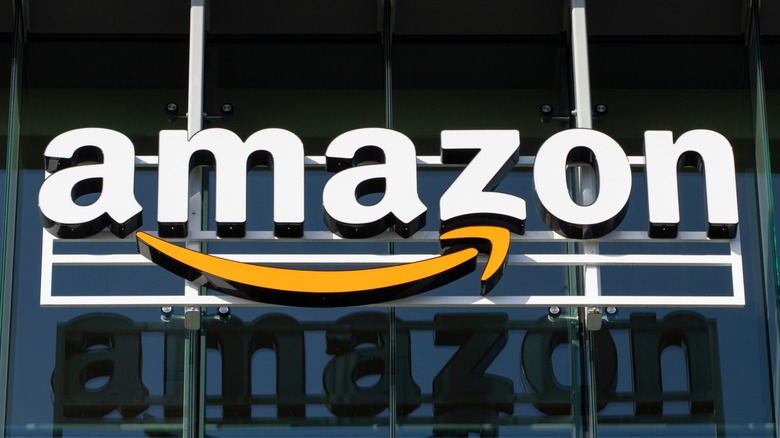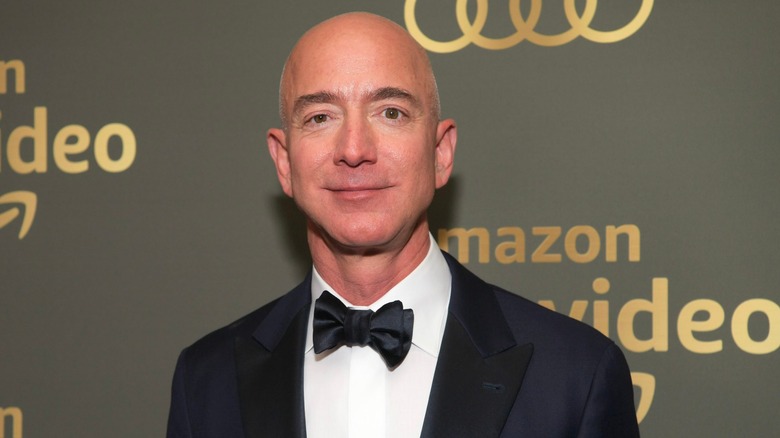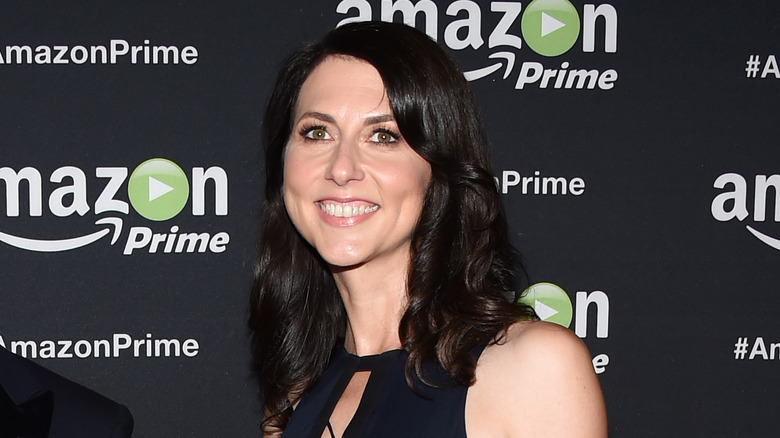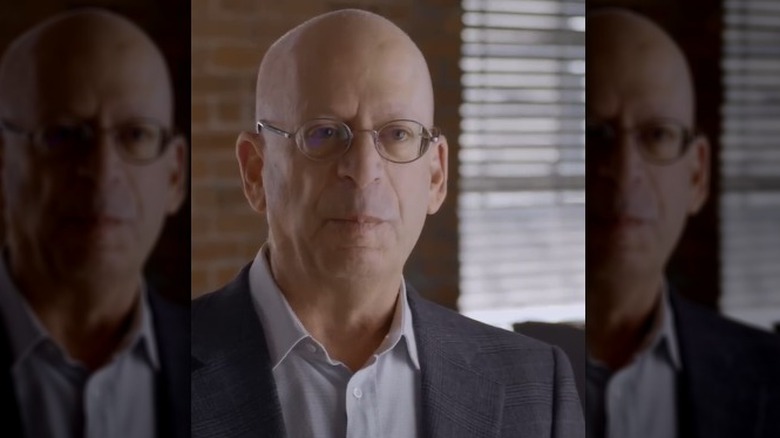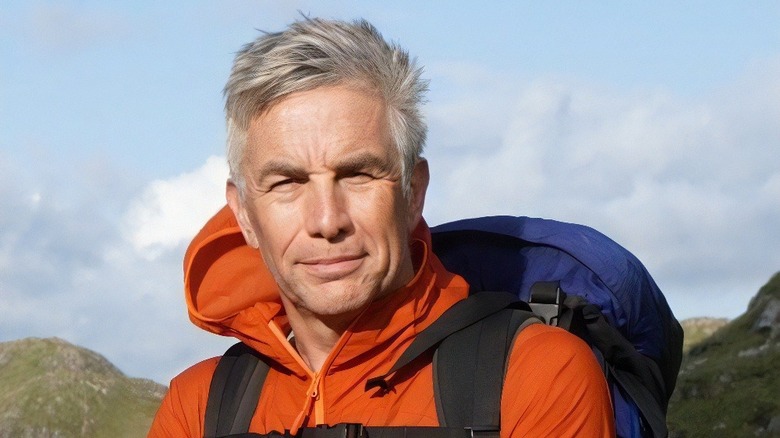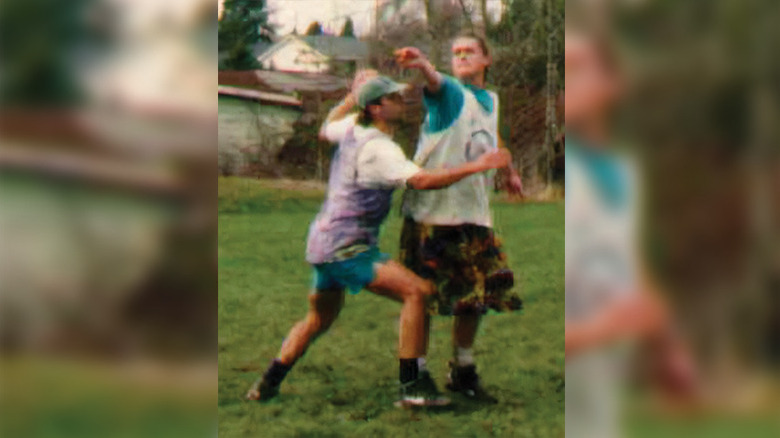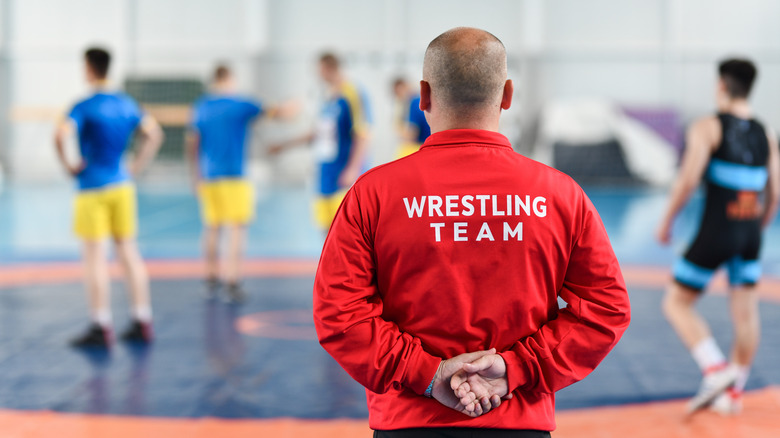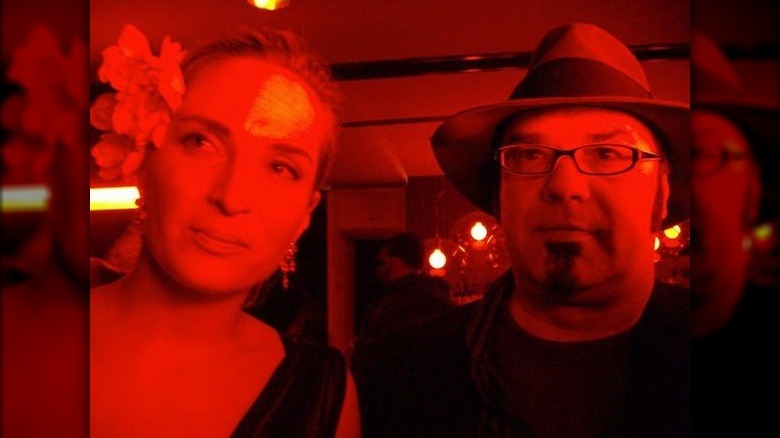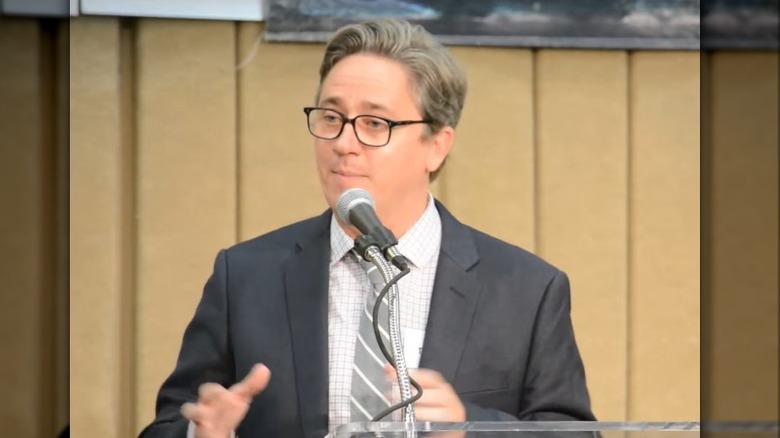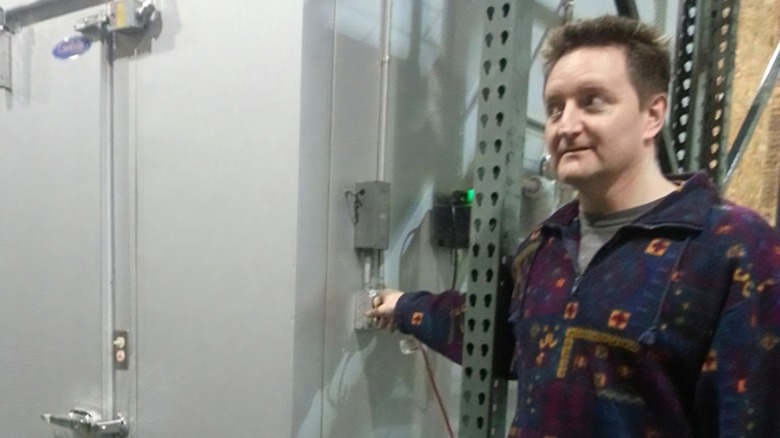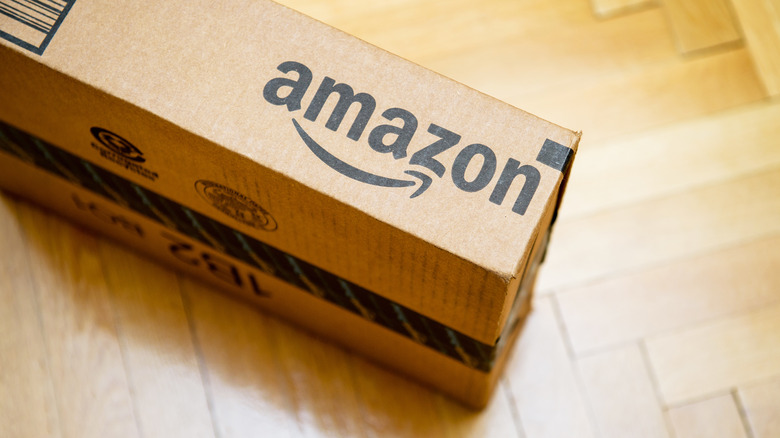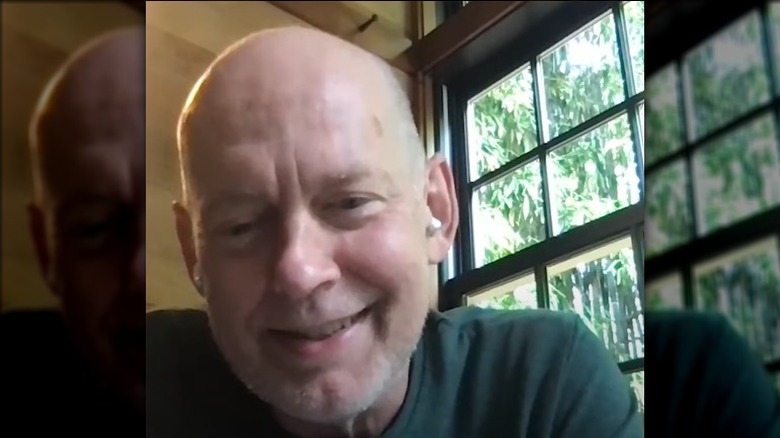Whatever Happened To Amazon's First Employees?
Founded by Jeff Bezos in 1994 with the help of his then-wife MacKenzie Scott, Amazon began as a tiny startup attempting to achieve the impossible: an online store that sold anything you needed and could be sent to you within just a few clicks. Bezos certainly achieved that dream, but it took a small army to help build Amazon's foundation and sustain its rapid growth. The company's first employees were an immensely talented group of individuals, who each used their own vast skill set to solve countless unique challenges. Without them, many of Amazon's most essential functions simply wouldn't exist today.
It's difficult to assemble a definitive list of where Amazon's first employees are now; some well-known early hires like Tom Schonhoff and Laurel Canan don't have much of an online presence. However, the ones that do have since become savvy entrepreneurs, generous altruists, and innovative leaders in their respective industries. Here are some of those inaugural members and what they have been up to since leaving the company.
Jeff Bezos
Jeff Bezos is Amazon's visionary founder and former CEO. He was working for investment firm D. E. Shaw when he and his boss, David Shaw, conceived the idea of "the everything store," a hypothetical online retailer that served as a middleman between businesses and consumers. Shaw was focused on the growth of his own firm, however, Bezos saw immense potential in the internet's growth and so decided to form his own company. Though he was discouraged by many to not leave his cushy corporate job, Bezos and then-wife MacKenzie Scott packed up their lives and made a cross-country move to Seattle in 1994 so they could start their company from scratch.
Today, Amazon is one of the world's most highly-valued companies, which has turned Bezos into, as of March 2024, the wealthiest person in the United States. Bezos oversaw the company's exponential growth across the 2000s and 2010s, which saw them develop several services and products for their consumers (Amazon Web Services, Alexa, Prime Video) and acquire other companies at a massive scale (Whole Foods, Audible, Twitch). Bezos has since become a leading voice in corporate America, but he has also faced controversy over monopolistic business practices and an unflinching standard for high productivity.
Bezos stepped down as CEO in 2021, but continues to expand his entrepreneurial pursuits as the founder of Blue Origin, one of the world's leading civilian-run space travel startups. The company has completed several successful space flights and plans to revolutionize commercial space travel.
MacKenzie Scott
Amazon's second employee was, naturally, MacKenzie Scott, Jeff Bezos' then-wife. Scott first met Bezos at D. E. Shaw when she worked as an administrative assistant to help support her dreams of becoming a novelist. The two quickly fell in love and, barely one year into their marriage, Scott agreed to move across the country and help Bezos kickstart Amazon. Despite Bezos' dominant public image, Scott was quietly instrumental in the company's development; she worked as their first accountant, shipped orders through UPS, and even helped come up with the name "Amazon." However, as the company grew bigger and bigger, she took a step back to focus on raising their four children as well as work on writing her first novel. The result, entitled "The Testing of Luther Albright," was released in 2005 to critical acclaim and modest financial success, leading to her second novel, "Traps," in 2013.
In 2019, Scott and Bezos announced their divorce, which many speculated would divide the Bezos family fortune. The final proceedings left Scott with a 4% stake in the company, making her one of the wealthiest women in the world. However, unlike most billionaires, a vast amount of her fortune has been donated to a variety of causes through her philanthropy platform, Yield Giving. As of June 2024, she has gifted well over 2000 different organizations amounts ranging between 5,000 to 10 million dollars.
Shel Kaphan
Amazon's first official hire was Shel Kaphan, who was so integral to Amazon's digital infrastructure that some spiritually credit him as a company co-founder. Kaphan was a programmer living in Santa Cruz, California, when his aspirations to explore the internet's mainstream potential led him to connect with Jeff Bezos. By the fall of 1994, he was convinced to join Amazon as its primary coder and began building its website from scratch. His tireless hours of work gave Amazon a foundation in online retail, but Bezos' restructuring of the company in anticipation of its 1997 IPO diminished Kaphan's role. Eventually, he was left with no managerial power and left the company in 1999 on bad terms with Bezos.
After leaving Amazon, Kaphan took a step back from corporate interests to recover after months of 80-hour work weeks and unending screen time. He chose to remain out of the public spotlight and dedicate much of his wealth to founding and funding The Kaphan Foundation, which provides grants to left-leaning organizations such as Planned Parenthood. Minus a few select interviews, Kaphan never expressed his feelings about Amazon's looming market presence until 2020, when, in an interview with Frontline, he expressed concern over the company's monopolistic growth and supported the idea of breaking it up, saying, "The main thing I am concerned about is just preserving the ability for small companies to innovate and to do so without fear of having their business taken away."
Paul Davis
One month after Shel Kaphan joined the team, Jeff Bezos hired British-born programmer Paul Davis. Though he was only at the company for just over a year, Davis was instrumental in building Amazon's IT backend, including systems for order processing, delivery tracking, credit card purchases, and search engines. However, Davis was also critical of Bezos and his insatiable workplace culture, even in the company's infancy. He chose to leave Amazon before his stock was vested both to spend more time with his newborn daughter and out of a disinterest in seeing the company grow. In a 2019 interview with Recode (since acquired by Vox), Davis publicly expressed support to break up the Amazon Marketplace, saying, "The company that operates the marketplace is also a retailer. They have complete access to every single piece of data and can use that to shape their own retail marketplace."
Shortly after his stint at Amazon, Davis joined Linux Audio Systems and began programming free, open-source software for audio production. Despite it beginning as a hobby, it has since become Davis' full-time job and his most recent claim to fame. In 2002, he developed the JACK Audio Connection Kit, a low-latency API that allows different applications and hardware systems to share audio information; the software won an Open Source Award in 2004. In 2005, he released Ardour, an acclaimed digital audio workstation that continues to release updates to this day. Currently, Davis lives in New Mexico and remains active on X, formerly known as Twitter.
[Featured image by Paul Davis via Uses This | Cropped and scaled | CC BY-SA 4.0]
Nicholas Lovejoy
Nicholas Lovejoy (pictured right) was Amazon's fourth employee, first encountering Jeff Bezos as a colleague during his time at D. E. Shaw. Lovejoy had left the firm to teach high school math in Seattle when Bezos hired him to work part-time for the company instead. One of Lovejoy's earliest contributions has since become a storied piece of Amazon lore. In the beginning, Bezos and his employees would pack shipping boxes on their hands and knees against a concrete floor. When Bezos complained that the process was straining his body, he suggested that he buy everyone kneepads. Lovejoy, understandably amused, suggested Bezos purchase tables instead. This became the blueprint for what would eventually become Amazon's vast packaging facilities, later dubbed "Fulfillment Centers."
After his first summer, Lovejoy was promoted to a full-time position and eventually became an IT manager. However, Lovejoy grew skeptical of Amazon's hyperproductive working conditions and saw himself losing sight of his family and his love for sports. In 1998, he left the company to travel the world with his girlfriend, Barbara Gordon, during which Lovejoy's stock tripled in value. The couple later founded the Gordon-Lovejoy Foundation in an effort to increase their philanthropy with their newfound wealth.
Mike Hanlon
Amazon's seventh employee was Mike Hanlon, who joined the company in 1995, and would work in several different departments, including real estate operations, wholesale ordering, business development, and software engineering. Before his departure in 2001, Hanlon oversaw the company's expansion from a bookseller into an "everything store" as its revenue increased over 300,000%. One of Hanlon's memorable experiences at Amazon was having his then-girlfriend and now-wife, Molly, pack so many book shipments with him that Jeff Bezos had her sign a nondisclosure agreement. In 1999, the couple co-founded the Hanlon Foundation and began giving out grants to a variety of charitable organizations; their work has continued up until as recently as 2022.
Hanlon described his time at Amazon as "a really intense experience ... when I left Amazon I thought 'Ah gosh, I wanna do something entirely different with my life'" (via Taking Notes). This inspired him to study Economics at the University of Washington. He graduated with a PhD and became an assistant professor for their Institute for Health Metrics and Evaluation, where he researched innovative ways to collect data on healthcare. This led him to form Abett, a software that helped employers access and assess data on their healthcare benefits. Since launching in 2018, the company has raised over $12 million dollars in venture capital. Outside of business, Hanlon is also a proud assistant wrestling coach for the Bainbridge High School Spartans.
Jonathan Kochmer
Beginning in 1995, Jonathan Kochmer wore a number of different hats at Amazon. Recruited by Bezos due to his early internet know-how, Kochmer helped conceive of Amazon's earliest online promotions while acting as a senior editor for its editorial content, writing thousands of book reviews and curating its featured titles. When Amazon expanded beyond books, he conceived of Amazon's now-essential "Browse" feature, amongst other data systems. Being an Amazon employee was intense for Kochmer; during one three-month period, he never left the office and simply showered at the Amazon headquarters.
Kochmer left the company in 2001, and has proceeded to lead a fascinating and varied career. He founded and ran an independent record label-turned-public relations firm, Sarathan Records, for fifteen years, during which he oversaw all aspects of the company's operations. One of the artists signed to the label was Two Loons For Tea, an alt-pop musical duo featuring Kochmer and musician Sarah Scott (both pictured above). So far, they have released three albums; their latest, "Nine Lucid Dreams," was nominated for Best Pop/Rock Album at the 2008 Independent Music Awards.
Kochmer is still involved in the tech world. He has contributed work on information systems for eco-friendly organizations, including nonprofit Earth Economics and Singapore-based startup Synectify, and is a supporter of modern tech solutions such as artificial intelligence, machine learning, and blockchain. Today, he travels the world making presentations on AI and serves as a mentor at LongHash Ventures, a global blockchain venture capital fund.
Tod Nelson
Tod Nelson joined Amazon in 1995, beginning as an operations manager at Amazon's then-basement warehouse. However, as the company grew, he strove to become part of the company's editorial team. Nelson became one of the site's original editors, managing an entire staff of freelance writers who contributed bios and reviews to the company's catalog, and retained the job as it expanded into selling music and videos. He also worked directly with authors and publishers to help them become part of the Amazon ecosystem, while helping the company launch part of its German expansion.
Nelson left Amazon in 2001 and moved to Los Osos, California, to settle down with his wife and newborn daughter. In 2014, he began lecturing at California Polytechnic State University, and eventually was hired as the executive director of their Center for Innovation & Entrepreneurship, which advises students on becoming business owners. He still holds the position to this day.
Nelson's life took an unexpected turn when he was diagnosed with interstitial lung disease, or scarring on the lungs, around his 50th birthday. Nelson proceeded to have two double lung transplants, one in 2018 and one in 2021, and used his passion for playing guitar as a way to stay connected to his love of music on his road to recovery.
Scott Northrop
Few Amazon employees can say they ever held a title as singular as "Unix Shaman," but that was what Scott Northrop chose to rock on his business card while at Amazon. Beginning in 1995, Northrop became one of the company's most essential Unix programmers, helping to invent systems that have had a lasting effect on the company. He helped automate a template for packing slips, solve the company's perceived Y2K bug, and, most importantly, operate the company's payment system, which grew the company's sales to one billion dollars a year.
Northrop's online footprint is minimal, but we do have a sense of what his life has been like since leaving Amazon in 2000. After 11 years as a partner with the now seemingly defunct company Fueling Technologies, he became CEO of Stark Raving Foods, a frozen pizza production company committed to being a gluten-free alternative without sacrificing taste or ingredients. The company began with Scott's brother, David Northrop, who worked his way up the ladder at Jet Set Pizza Co. before it was acquired by the company Garlic Jim's in 2008. When Garlic Jim's found major success with a gluten-free department, David combined forces with Scott, acquired the department, and rebranded it as Stark Raving Foods. However, that came to a halt in 2019 when the company closed due to rising costs in their lease agreement. Any of Scott's endeavors since then remain offline.
Ellen Ratajak
Ellen Ratajak joined Amazon in March of 1996 and became an IT director, developing software that automated the company's Fulfillment Centers and their delivery systems. She also improved the company's customer service and even helped initiate Amazon Associates, an affiliate marketing program that allows online content creators to earn extra income by recommending Amazon products to their audience. Ratajak has previously been critical but understanding of Jeff Bezos' behavior, telling The Washington Post in 2013, "[He] could be a royal a**hole [with] irrational stubbornness ... But I do see a heart in Jeff ... [He] didn't want to just please customers or build loyalty. He wanted to delight customers."
Ratajak retired shortly after she left Amazon in 2001, although numerous altruistic efforts have since brought her out of retirement. In 2010, she became a board member of Organically Grown Co., a wholesale provider of organic produce throughout the Pacific Northwest; she specifically served as board chair between 2014 and 2016. While on the board, she also became part of the U.S. Digital Services team for the U.S. Department of Veterans Affairs, or V.A. for short, helping the department use technology to better understand and deliver services to veterans. Shortly after leaving the board in 2018, she became a committee member of Organically Grown's offshoot trust, the Sustainable Food and Agriculture Perpetual Purpose Trust. She held this position until 2019. Ratajak's efforts since then are currently unknown.
Eric and Susan Benson
Jeff Bezos and MacKenzie Scott began Amazon as a couple, but they weren't the only couple who worked there. Eric and Susan Benson joined the company together, though they contributed in different ways. Eric was a software engineer who pioneered the site's "Similarities" function, which recommended additional books based on the one you were currently browsing. He also oversaw the transition from Unix to Linux operating systems.
Susan served as editor-in-chief, crafting Amazon's "voice" – the copy customers would read as they went through the order process – as well as their editorial style guide. However, their most important contribution may have been their dog, Rufus, who paved the way for Amazon's pet-friendly work policy and became a good luck charm for the company's infancy; employees would make sure Rufus tapped his paw onto the keyboard as a superstition before launching a new feature.
Though Rufus passed away in 2009, Eric and Susan are alive and kicking. Their primary efforts have been in civil service; both of them have used their previous Amazon expertise to work for the United States Digital Service, assisting government departments with technology that can better serve citizens, as well as the Democratic National Committee. Susan has also served as president and board chair for Town Hall Seattle, the city's arts center, and volunteered for Barack Obama's 2008 political campaign. Though she appears to be retired since 2018, Eric continues to work as an independent consultant.
